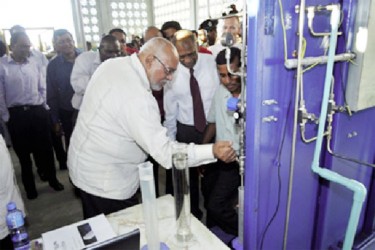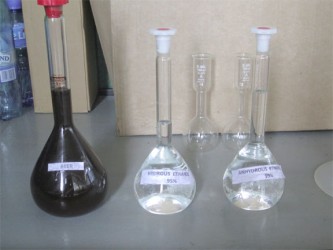GuySuCo yesterday commissioned its $85 million Bioethanol Demonstration Plant at the Albion Estate, where it was hailed as a “stepping stone for greater things” despite not being a commercial venture.
Minister of Agriculture Dr Leslie Ramsammy said that this demonstration plant could begin the revolution in agro fuel, while proclaiming that Guyana was well on its way to having local technologies leading the bioethanol industry.
GuySuCo CEO Paul Bhim, however, stressed that the plant was a demonstration plant and it was never intended for commercial results.
He told reporters that the Inter-American Development Bank (IDB) provided $67 million in funding, while GuySuCo provided the rest of the funds. He noted that the plant would be used for training purposes and that to be a commercial option meant that it would need to be used throughout the year, which was not the plan. Bhim stated that the plant would be used during the 32-week season because steam from the factory was required.

He did say that the plant was a “stepping stone for greater things” but did not allude to where Guyana would go next in the production of bioethanol and biodiesel fuel sources. Bhim did stress that the plant was the first of its kind in Guyana and that so far the production capabilities would ensure that GuySuCo could acquire its alcohol source from the plant and a portion of the anhydrous ethanol, which has as purity of 99.6 percent, would be combined and used as a fuel enhancer.
The anhydrous ethanol in its purest form will be used to fuel vehicles at GuySuCo and make E10 fuel, which is 10 percent ethanol, to fuel Ministry of Agriculture vehicles.
Bhim noted that the Albion Estate is one of the highest producers of sugar and the blackstrap molasses by-product was being utilised at the plant to produce the anhydrous ethanol. The plant has the capabilities to produce 1,000 litres of the finished product and has a ration capability of 250 litres per tonne of molasses.
Dr Clairmont Clementson, Bioenergy Programme Coordinator at the Agriculture Ministry, stated that the vision for the plant was in place since a Memorandum of Understanding (MOU) was signed in 2007 between the IDB, the Organisation of American States and the Government of Guyana to promote renewable energy and bioenergy projects. He said that Guyana initiated an agro energy policy in the same year and the IDB agreed to assist with funding of small-scale bioenergy demonstration projects. It was five years later that the Agriculture Ministry approached GuySuCo and signed its own MOU for the installation of the plant. He said that the objectives were to “demonstrate the production of fuel grade ethanol locally, provide the source for demonstrations of ethanol as a vehicle fuel and develop a facility for the training of local personnel in biofuel technologies.”

He noted that with the assistance from Green Biorefineries of Brazil and Whitefox Technologies Limited of Canada, the acquisition of equipment and installation was done. He did say that under the guidance of Sharma Dwarka the plant would be used as a training facility. He also said that the future meant “also expanding the demonstration capability of the plant by mechanising the vinasse to produce biogas,” which would mean that Guyana could have the capabilities to produce a renewable energy source.
President Donald Ramotar was on hand to cut the ribbon at the commissioning, while representatives from the plant, Green Biorefineries of Brazil and Whitefox Technologies Limited gave a rundown of how fermentation, distillation and dehydration worked to produce the final anhydrous ethanol.
So far, 50 participants from 15 different agencies have undergone training at the plant, including candidates from the Guyana Energy Agency, the GuySuCo Training Centre, the National Agriculture Research and Extension Institute and the University of Guyana.




